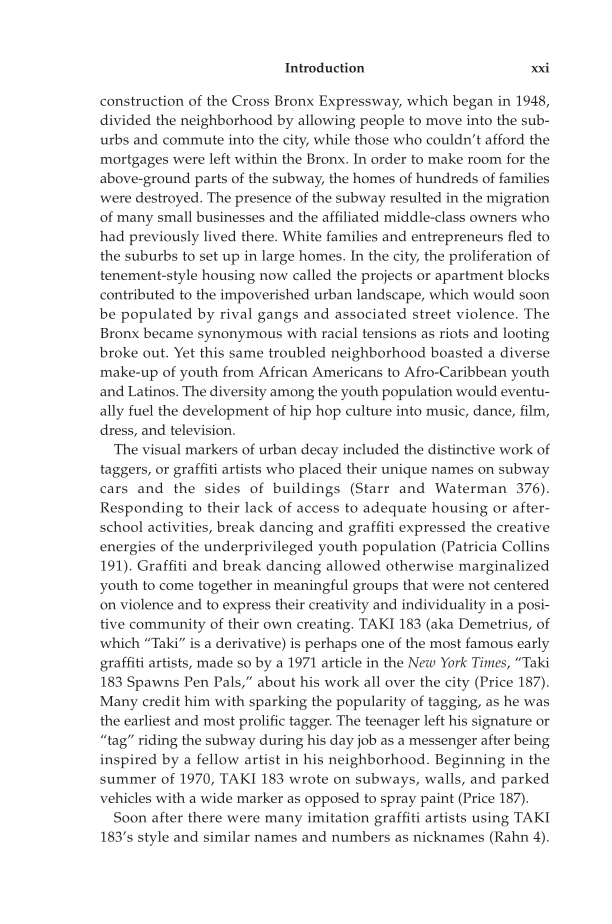construction of the Cross Bronx Expressway, which began in 1948, divided the neighborhood by allowing people to move into the sub- urbs and commute into the city, while those who couldn’t afford the mortgages were left within the Bronx. In order to make room for the above-ground parts of the subway, the homes of hundreds of families were destroyed. The presence of the subway resulted in the migration of many small businesses and the affiliated middle-class owners who had previously lived there. White families and entrepreneurs fled to the suburbs to set up in large homes. In the city, the proliferation of tenement-style housing now called the projects or apartment blocks contributed to the impoverished urban landscape, which would soon be populated by rival gangs and associated street violence. The Bronx became synonymous with racial tensions as riots and looting broke out. Yet this same troubled neighborhood boasted a diverse make-up of youth from African Americans to Afro-Caribbean youth and Latinos. The diversity among the youth population would eventu- ally fuel the development of hip hop culture into music, dance, film, dress, and television. The visual markers of urban decay included the distinctive work of taggers, or graffiti artists who placed their unique names on subway cars and the sides of buildings (Starr and Waterman 376). Responding to their lack of access to adequate housing or after- school activities, break dancing and graffiti expressed the creative energies of the underprivileged youth population (Patricia Collins 191). Graffiti and break dancing allowed otherwise marginalized youth to come together in meaningful groups that were not centered on violence and to express their creativity and individuality in a posi- tive community of their own creating. TAKI 183 (aka Demetrius, of which “Taki” is a derivative) is perhaps one of the most famous early graffiti artists, made so by a 1971 article in the New York Times, “Taki 183 Spawns Pen Pals,” about his work all over the city (Price 187). Many credit him with sparking the popularity of tagging, as he was the earliest and most prolific tagger. The teenager left his signature or “tag” riding the subway during his day job as a messenger after being inspired by a fellow artist in his neighborhood. Beginning in the summer of 1970, TAKI 183 wrote on subways, walls, and parked vehicles with a wide marker as opposed to spray paint (Price 187). Soon after there were many imitation graffiti artists using TAKI 183’s style and similar names and numbers as nicknames (Rahn 4). Introduction xxi
Document Details My Account Print multiple pages
Print
You have printed 0 times in the last 24 hours.
Your print count will reset on at .
You may print 0 more time(s) before then.
You may print a maximum of 0 pages at a time.

































































































































































